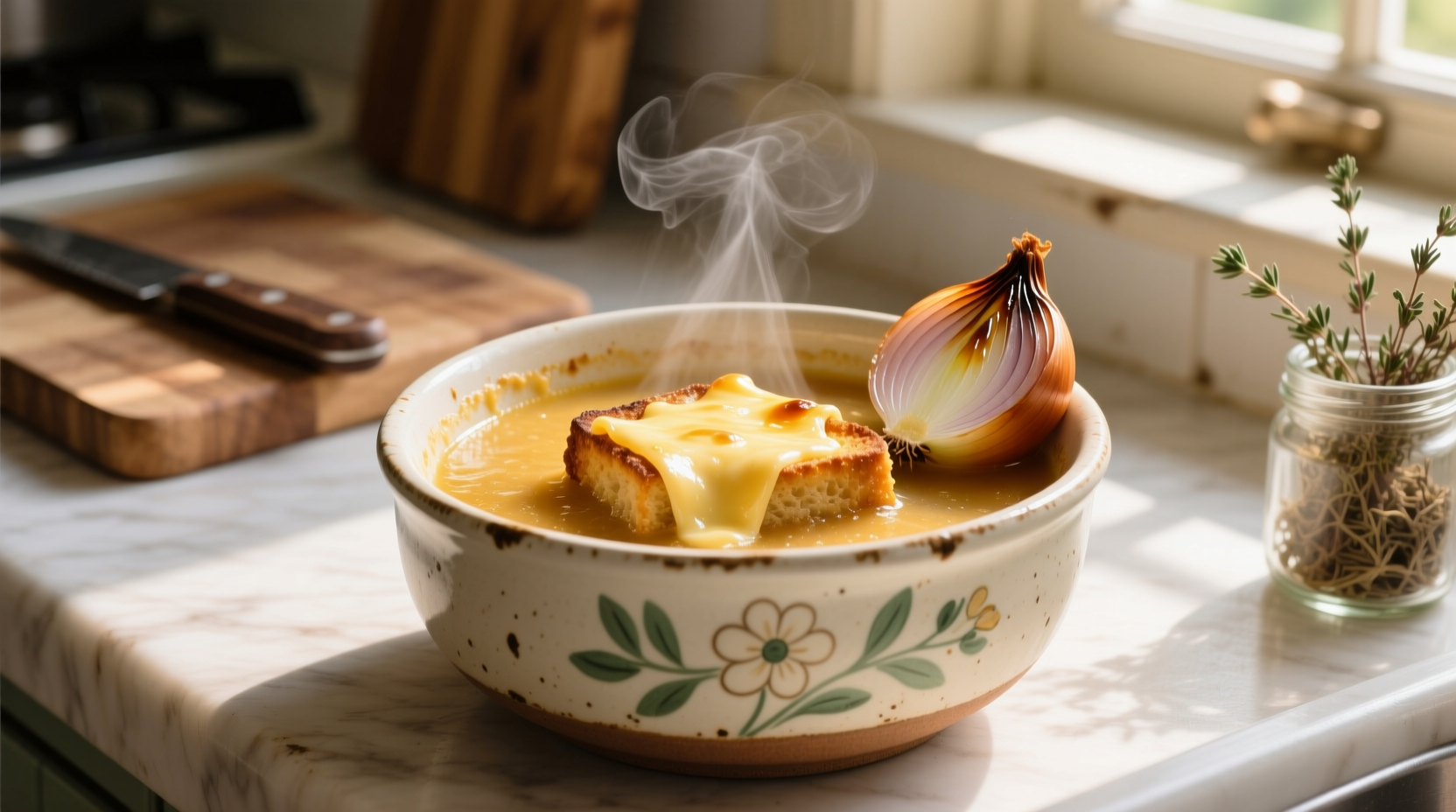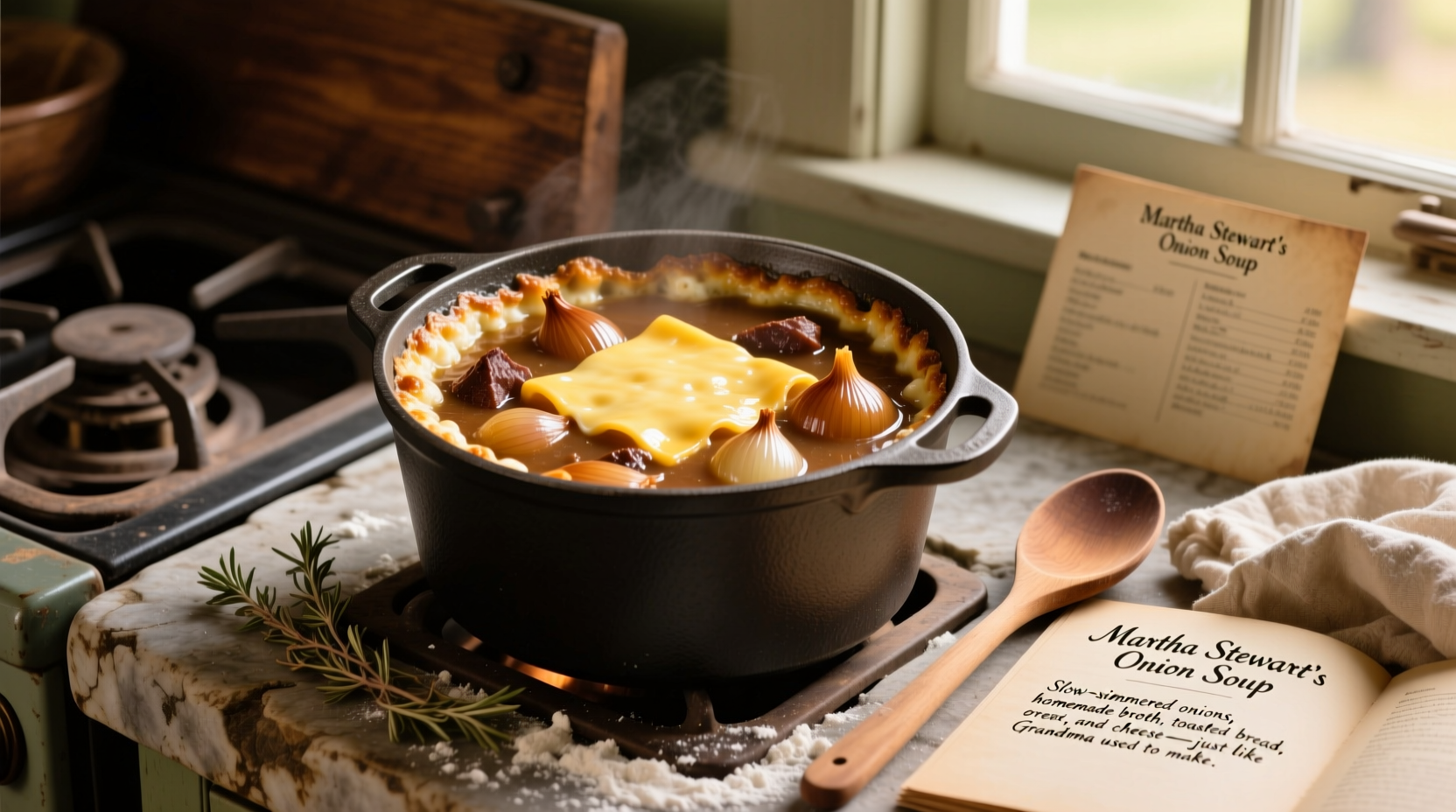Discover why Martha Stewart's French onion soup has become the gold standard for home cooks seeking authentic Parisian bistro flavor. This meticulously crafted recipe transforms humble ingredients into a luxurious comfort food experience through precise technique and attention to detail. Whether you're preparing an elegant dinner party starter or seeking the ultimate cold-weather comfort meal, Stewart's approach delivers consistent, restaurant-quality results that elevate this classic French dish beyond ordinary soup recipes.
The Essential Ingredients That Define Martha Stewart's Version
What separates Martha Stewart's French onion soup from other recipes? The magic lies in her specific ingredient selection and preparation methods. While traditional French onion soup uses yellow onions, Stewart recommends a blend of yellow and sweet Vidalia onions for complex flavor development. Her recipe calls for:
- 4 pounds mixed yellow and sweet onions, thinly sliced
- 3 tablespoons unsalted butter plus olive oil
- 1 teaspoon fresh thyme leaves
- 1 bay leaf
- 1 bottle (750ml) dry white wine or dry vermouth
- 6 cups homemade beef stock (or high-quality store-bought)
- Freshly grated Gruyère cheese
- Baguette slices, toasted
- Freshly cracked black pepper
Unlike many simplified versions, Stewart insists on using real Gruyère rather than Swiss or other substitutes, explaining that its nutty flavor and superior melting properties create the authentic cheese crust essential to proper French onion soup.
| Traditional French Onion Soup | Martha Stewart's Version |
|---|---|
| Yellow onions only | Mixed yellow and sweet onions |
| Butter only | Butter and olive oil combination |
| Dry red wine | Dry white wine or vermouth |
| Basic beef broth | Rich homemade-style stock |
| Generic "cheese" topping | Specifically Gruyère cheese |
This ingredient comparison shows how Stewart's thoughtful modifications enhance traditional preparation while maintaining authenticity. The white wine substitution, for instance, creates a brighter flavor profile that complements rather than overwhelms the delicate onion sweetness.
Step-by-Step Preparation: Mastering the Caramelization Process
The foundation of exceptional French onion soup lies in proper caramelization—a process where Stewart dedicates nearly an hour. Her method transforms raw onions into sweet, jam-like morsels through careful temperature control:
- Melt butter and olive oil together in a heavy-bottomed Dutch oven over medium heat
- Add sliced onions and stir to coat with fat, then reduce heat to medium-low
- Cook uncovered for 45-60 minutes, stirring every 5-7 minutes
- Wait until onions reach deep golden brown color before proceeding
- Add thyme, bay leaf, and a pinch of sugar to enhance caramelization
- Pour in wine to deglaze the pot, scraping up all browned bits
- Add stock and simmer for 30 minutes to develop flavors
Food science research from the USDA National Institute of Food and Agriculture confirms that the Maillard reaction occurring during proper caramelization creates over 600 flavor compounds, explaining why rushing this step produces inferior results. Stewart's patience here makes all the difference between good and extraordinary soup.

Avoiding Common Preparation Mistakes
Even experienced cooks encounter pitfalls when preparing French onion soup. Martha Stewart's recipe addresses these specific challenges:
Problem: Onions burning or cooking unevenly
Solution: Use a heavy-bottomed pot and maintain consistent medium-low heat. Stir regularly but not constantly—allowing onions to sit briefly promotes even browning.
Problem: Soup tastes bitter
Solution: Never use high heat during caramelization. If onions begin to blacken, start over—burnt bits cannot be salvaged.
Problem: Cheese topping doesn't form proper crust
Solution: Use authentic Gruyère cheese and broil until bubbling but not blackened. The USDA Agricultural Research Service confirms Gruyère's superior melting properties due to its specific protein structure.
Serving Perfection: Presentation and Pairing Tips
Martha Stewart's attention to presentation transforms French onion soup from simple comfort food to elegant dining experience. Follow these professional techniques:
- Use oven-safe ceramic crocks that can go directly from stove to table
- Float 1-2 toasted baguette slices on each serving before adding cheese
- Generously cover with freshly grated Gruyère (pre-grated cheese contains anti-caking agents that prevent proper melting)
- Broil until cheese forms a golden, bubbly crust
- Serve immediately while cheese is still molten
For beverage pairing, Stewart recommends a dry French white wine like Chablis or a light-bodied red such as Beaujolais. The Wine & Spirit Education Trust research shows these varieties complement the soup's rich umami flavors without overwhelming the delicate onion sweetness.
When This Recipe Works Best (And When to Choose Alternatives)
Understanding the context boundaries for Martha Stewart's French onion soup helps determine when it's the ideal choice:
- Perfect for: Special occasions, dinner parties, cold weather comfort, when you have 90 minutes for preparation
- Consider alternatives when: You need a 30-minute meal, cooking for dairy-free guests, or seeking a vegetarian version (traditional recipe uses beef stock)
- Vegetarian adaptation: Substitute high-quality mushroom or vegetable stock and double the onions for depth
- Time-saving tip: Caramelize onions one day ahead—they actually improve with resting time
Professional chefs at the Culinary Institute of America note that French onion soup represents one of the most technique-sensitive classic dishes, where small variations in preparation significantly impact final quality. Stewart's method provides the most reliable path to authentic results for home cooks.
Storage and Reheating for Perfect Leftovers
While French onion soup is best enjoyed fresh, proper storage maintains quality for later enjoyment:
- Cool soup completely before storing (never add hot soup to containers)
- Store base without cheese topping in airtight containers
- Refrigerate for up to 4 days or freeze for 3 months
- Reheat gently on stove—never boil, which can make broth bitter
- Add fresh cheese topping when serving reheated portions
Food safety guidelines from the FDA emphasize that proper cooling and storage prevents bacterial growth in cooked soups. Always reheat to 165°F (74°C) internal temperature for safety.
Martha Stewart Onion Soup Timeline: From Bistro Classic to Home Kitchen Favorite
Understanding the historical context enhances appreciation for this beloved recipe:
- 18th Century: French onion soup originates as peasant food in Paris bistros
- 1860s: Appears in first French cookbooks as "soupe à l'oignon gratinée"
- Early 1900s: Gains popularity in American restaurants through French chefs
- 1990s: Martha Stewart publishes her refined version in "Entertaining"
- 2000s: Becomes staple recipe in American home cooking through her television shows
- Present: Recognized as the definitive home preparation method
This evolution shows how Stewart's recipe bridged the gap between authentic French technique and accessible home cooking, preserving tradition while adapting for modern kitchens.











 浙公网安备
33010002000092号
浙公网安备
33010002000092号 浙B2-20120091-4
浙B2-20120091-4